After over an hour of driving (it takes forever to drive anywhere in Yellowstone due to all of the animal jams), we made it to the Old Faithful area, which was a complete zoo. We spent a good 15 minutes driving around the parking lot looking for a spot. When we finally got into the visitors center, we found out that they don’t issue backpacking permits – we had to go to the ranger station, a goodly hike across the vast expanse of asphalt and vehicles. When we got to the ranger station, we immediately found the backcountry office, but it was closed due to an emergency. A ranger clearly in a hurry rushed past Brian and said she had no clue when the office would open again – the ranger had to leave the office for an emergency carry-out of an injured hiker. Ugh. OK, so a hiker gets hurt, and the ranger has to temporarily close the backcountry office to participate in the rescue. Makes sense. But shouldn’t another ranger be able to step in and reopen the office? In our short time at Yellowstone so far, it hadn’t seemed like there was any shortage of rangers.
So now we had to go to Grant Village, the next-nearest backcountry office, another long drive away. When we arrived at the ranger station, it was closed. We thought we’d been foiled yet again in our quest to get a permit but then noticed a note indicating that here backpacking permits are issued at the visitors center, not the ranger station. At the visitors center, we finally found a real live ranger! Even better, this guy actually had a clue – he was able to discuss different routes with us and offer advice.
Shoshone Lake, as it turns out, is a very popular backpacking trip, in large part because it’s one of the few longer-distance loop routes in the park. Yellowstone is America’s oldest national park (established in 1887), and when its trail system was built, recreational hiking wasn’t really something that people did. Some extreme nature lovers like John Muir hiked, but it wasn’t the widespread pastime that it is today. So the trail system wasn’t built for hikers, but rather for rangers on horseback to be able to get from one part of the park to another as quickly as possible. So Yellowstone lacks the great backpacking routes that, say, Glacier or Grand Teton has.
Shoshone Lake, in addition to being a popular backpacking trip, is also popular with boaters, and most of its campsites are accessible from the lake only, not from the trail. So although the ranger tried his hardest to find a sequence campsites that would work for us for a three-day trip, Shoshone Lake was too booked up for us to get in. Same thing with Heart Lake, another popular backpacking lake, which would have just been an out-and-back hike.
Shoshone and Heart Lakes are near Grant Village, so they would have been convenient to get to from the backcountry office. But now we started looking farther afield for backpacking routes. The lack of available campsites was an obstacle in the extremely popular areas, but throughout the park, snowpack and river fords were two other serious obstacles. This past winter, the West saw a huge amount of snowfall, so the high elevations are staying snowed in much later than normal. The spring melt is also heavier and later than normal, so rivers that would normally fordable at this time of year are still too dangerous. And as an added bonus, melting snow brings water, and water brings mosquitoes, so the mosquitoes are awful throughout much of the park.
Eventually, we settled on hiking into the Black Canyon of the Yellowstone. It’s at the northern end of the park, which is at lower elevations, so it melted and dried out weeks ago, meaning no snowfields to traverse and, hopefully, fewer mosquitoes. We’d hike in from the Hellroaring Creek trailhead and then hike along the Yellowstone River a ways through the Black Canyon of the Yellowstone, camping for three nights total. And although it was getting late in the day, we could plan our trip with just a two-mile first day, so we could get started this evening. Hopefully, the several hours that we’d spent tracking down a backcountry permit would be worth it.
We drove about 1.5 hours from Grant Village to the trailhead, stopping at the Tower general store for some ice cream. An ambulance and a half dozen park personnel were in front of the store when we arrived, along with several crying people who didn’t speak English. It turned out that someone, a friend or family member of theirs, had had a heart attack at the general store and died. Wow. That really put our frustrating day into perspective.
Over the course of the day, we did see some good wildlife. In the morning, we saw buffalo right beside the road.
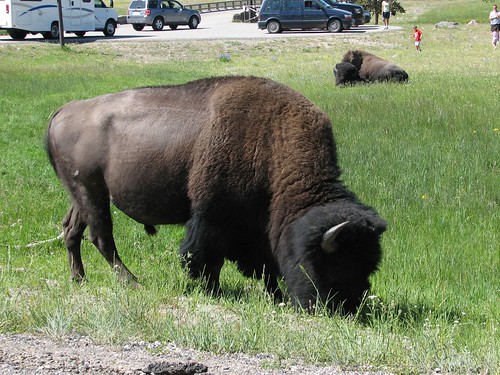
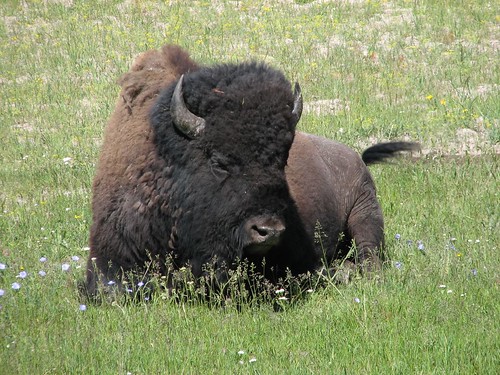
And in the afternoon, a black bear was hanging out at the side of the road.
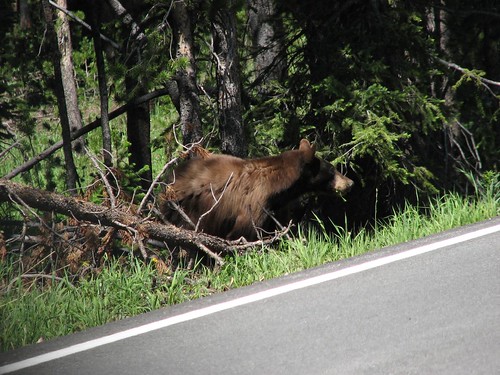
It was well after 6 PM when we arrived at the trailhead and started hiking. The mosquitoes were voracious – we both wore long sleeves and pants, and Brian wore a mosquito head net to ward them off. It was a lovely area, though, with wildflower-filled meadows and the Yellowstone River running through.
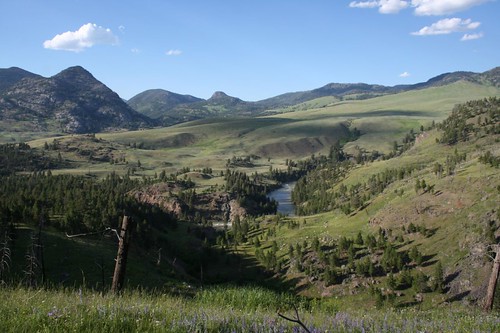
We pretty much raced to our campsite, since stopping meant losing blood to a swarm of mosquitoes (and this was supposed to be the less buggy part of the park…). We crossed the Yellowstone River on a suspension bridge and then hiked up Hellroaring Creek a ways to our assigned site. It was maybe 2.5 miles from the trailhead, mostly downhill – about the right distance, considering that we got to the campsite around 8 PM. We made a quick dinner and then hid in our tent. As we lay there, we counted the mosquitoes that took up residence on the underside of the rainfly of our tent. The count got up to 60 or so. It was a crazy sight to see – instead of counting stars or sheep, we were counting mosquitoes.
The next morning, the mosquitoes were gone, thankfully. We continued hiking up Hellroaring Creek.
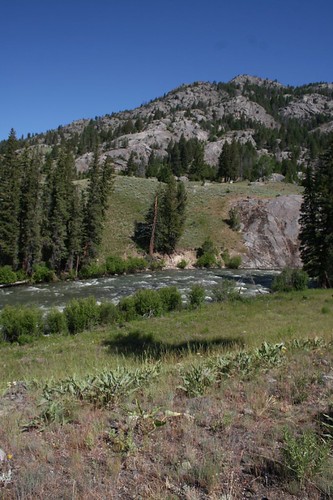
Shortly, we reached the stock bridge across the creek, where the water rushed below our feet.
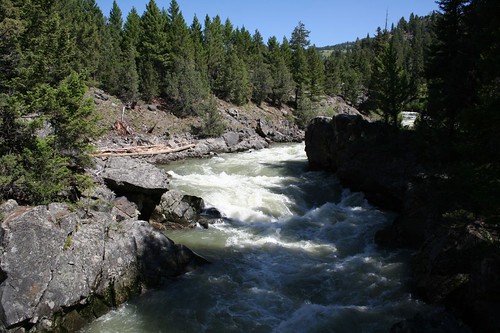
We walked down the opposite side of the creek, with more great views and still more wildflowers.
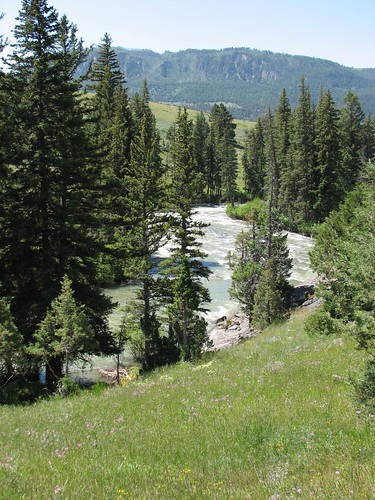
Eventually, the trail angled away from Hellroaring Creek, cutting the corner made by the confluence of Hellroaring Creek and Yellowstone River. We walked across open wildflower meadows.

Finally, we reached the Yellowstone River again. The Hellroaring Creek diversion was really just to get to the stock bridge. Later in the summer, when the water isn’t running as hard, hikers can ford Hellroaring Creek, but given the high water levels, we had to hike almost two miles up the creek to cross the bridge and then another two miles back down. No complaints, though – it was a pretty hike along the creek.
Here’s the Yellowstone from a high point on the trail.
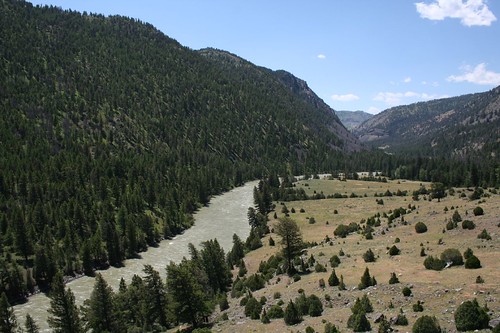
Today, we were camping right on the Yellowstone River.
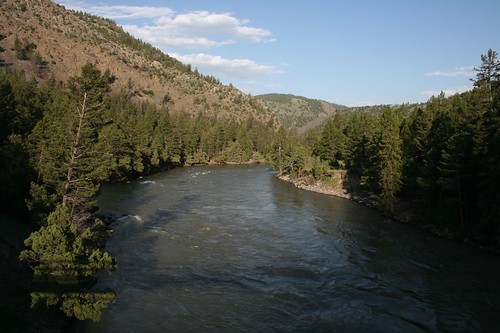
Tonight’s campsite was windier than the previous night’s, so mosquitoes weren’t nearly as much of a problem. We set up camp and made dinner and then hiked farther down the Yellowstone River, eventually stopping at another suspension bridge before returning. We carefully navigated around a snake along the way.
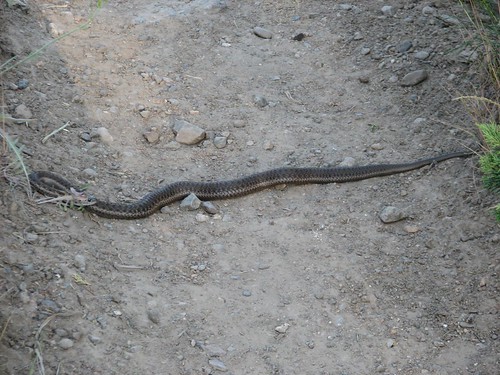
We had hoped to find a creek feeding into the river, but no luck – we’d have to filter some drinking water from the Yellowstone, which was awfully silty and smelled a bit like rotten eggs. Sure enough, it did a good job of clogging up our filter, but after cleaning the filter, we had enough water to get us to a clearer stream the next day.
At this point, we had seen a couple of other day hikers the previous evening as we hiked into Hellroaring Creek, and we’d seen nobody all day today, even on one of the few good backpacking routes available this time of year. Yellowstone truly is a park for SUV and tour-bus crowd. Over three million people visit Yellowstone each year, and only a tiny percentage of those venture off the nature trails and boardwalks and roadside pullouts.
The next day, we enjoyed our lovely campsite a bit longer and took a couple of pictures before leaving to retrace our steps back toward the trailhead.

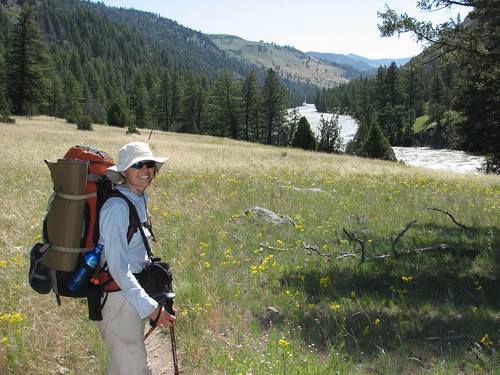
Throughout the hike so far, we’d seen lots of animal bones, antler sheds, and large animal scat (buffalo and elk, probably), but no live large animals. Today, alongside the trail, we saw the most curious thing so far: an antler shed stuck through a tree.

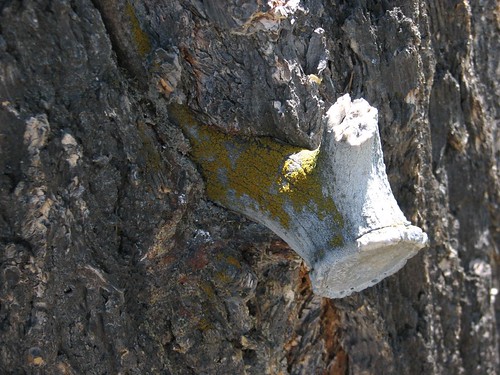

We guess the elk shed his antlers on or in the tree when the tree was much smaller, and the tree just grew up around them. Pretty wild, though.
We got more good views of the Yellowstone as we climbed back up.
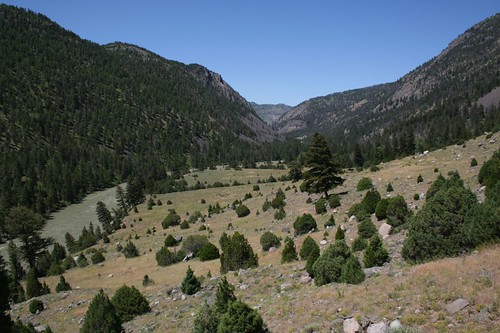
We saw quite a few butterflies as we hiked. Unfortunately, the butterflies were most prevalent on the rare muddy sections of trail, exactly where the mosquitoes also like to hang out. But this one stopped and posed so nicely that we had to take a picture.

This burned tree stood alone in the middle of a wildflower-filled meadow.

And just beyond the burned tree, we saw our first big animal of the trip – a lone buffalo!
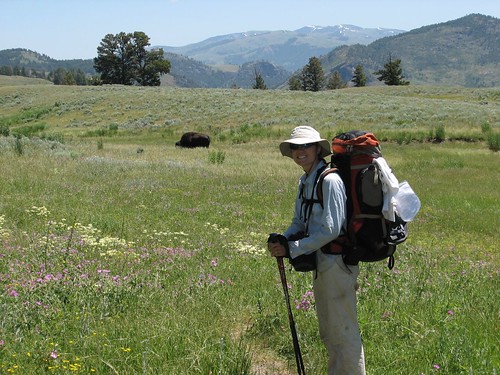

It was a good distance away, but as we continued hiking, suddenly the buffalo jumped and ran up the slope a ways. Apparently, it hadn’t realized we were there and just got wind of us. It didn’t look too happy.
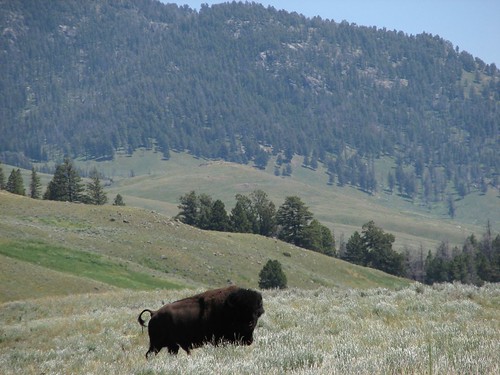
It had its tail raised, which Sarah at first took to mean it was angry. But no, as it turned out, it was just going to the bathroom.
We saw lots of pretty flowers but especially liked this one.
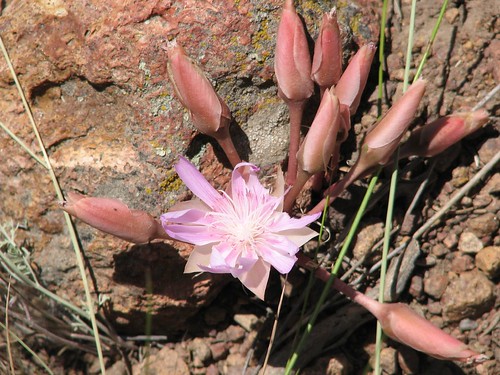
We not only saw lots of antler sheds, but even the occasional skull with antlers attached.

Sometimes, this hike was like walking through a big-animal graveyard.
Tonight’s campsite was along Hellroaring Creek, and it turned out to be in a beautiful meadow.
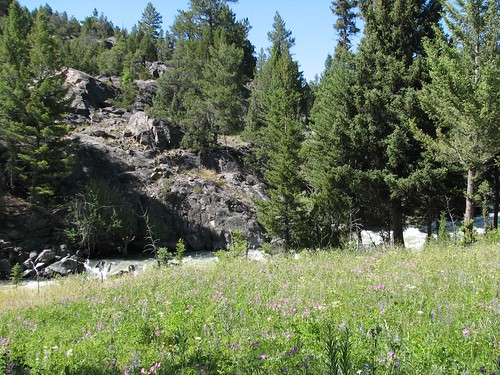
Sarah was happy to take her hiking boots off and sit down in her camp chair.

Still more antlers were to be found, right in our campsite.
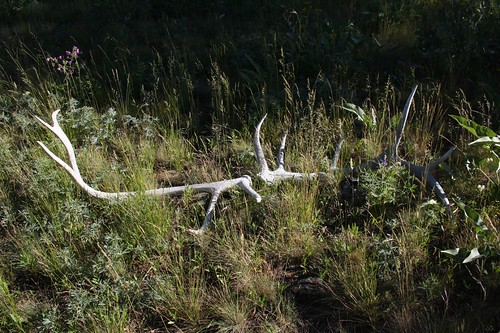
Before we left the next morning, we found another skull and antlers, this one with the fur still on.
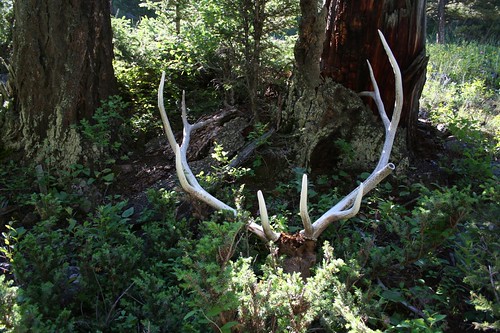
And as if that wasn’t gruesome enough, a few scattered bones.
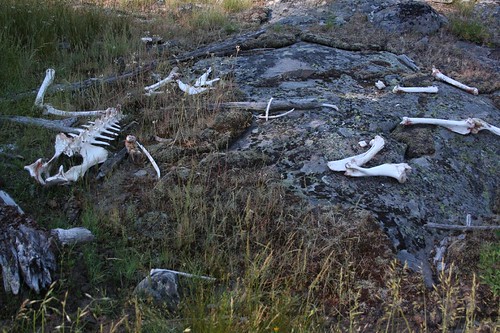
We took a last picture of Hellroaring Creek as we headed out.
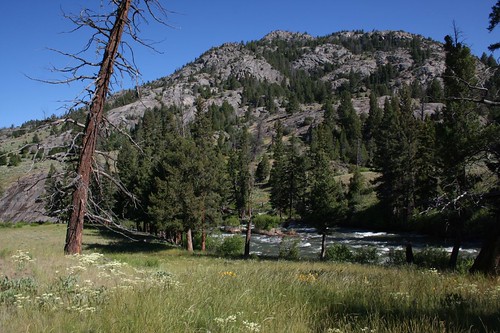
Here’s Brian at a rest break – we’re almost back to the trailhead!
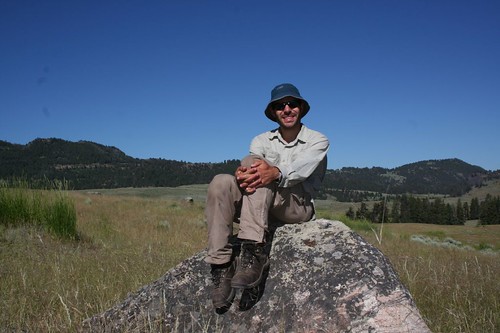
We climbed the steep trail back up from the Yellowstone River back to the trailhead, taking a last photo looking back.
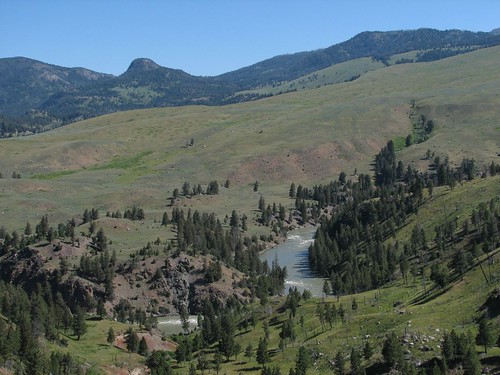
Then we reached the trailhead, a little before 11 AM on Saturday. We’d hiked around 27 miles in two full days, an evening, and a morning. Now that we’d seen a bit of the backcountry, we headed out to do some frontcountry sightseeing!
4 comments:
Great backpacking report, I am going out to yellowstone at the end of Aug to do some backpacking, looking around for good 1-2 suggestions. Know any good resources or ways to figure out a proper loop well in advance? I appreciate any help. Keep up the adventures!
Rob.
rob.bronstein@gmail.com
The backpacking guide on Yellowstone's website has a good overview of all the backcountry campsites with the popular areas highlighted. You can find it here: http://www.nps.gov/yell/planyourvisit/backcountrytripplanner.htm You might also check out the Falcon book "Hiking Yellowstone" for suggestions. Since we've only done one backpacking trip in Yellowstone, we can't comment personally on the other options. Based on our investigation though, most of the hikes do require a shuttle or backtracking.
If your travel plans aren't already set and your primary goal for this trip is great backpacking, I'd highly recommend going to Grand Teton instead. We've taken a couple of trips there and never been disappointed. Stay tuned and we'll have photos of our recent trip there posted soon. Grand Teton also has numerous options for loop hikes.
Thanks for the suggestions, we are stopping by Tetons but mainly to do some climbing, and hoping to do backpacking more in yellowstone to see some wildlife and such. Hopefully I will be able to piece together some 1-2 night backpacks without too much backtracking.
hi,
Could you describe your end point of the hike?
I understand it wasnt a loop trail.
thank you
assaf
sheffera1703@gmail.com
Post a Comment